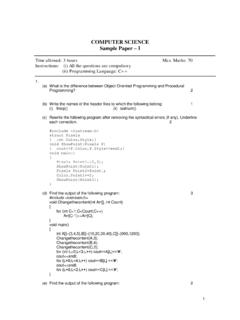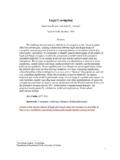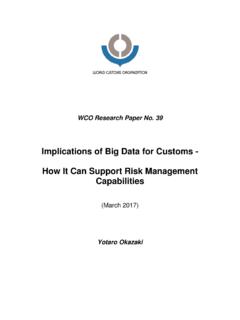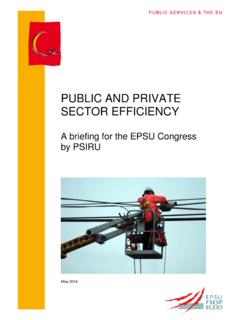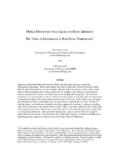Transcription of Eximchain: Supply Chain Finance solutions on a …
1 eximchain : Supply Chain Finance solutions on a securedpublic, permissioned blockchain hybridJuan Huertas , Hope Liu and Sarah RobinsonDate of Whitepaper: March 13th 2018 V6 ABSTRACTE ximchain brings visibility to global Supply Chain Finance (SCF) through smart contracts. We build a public , permis-sioned Chain for small-and-medium enterprise (SME) buyersand suppliers to create Supply Chain optimization tools andgain access to affordable capital sources to grow their busi-nesses. Our smart contract-based ecosystem allows SMEs toquickly implement customized SCF solutions or issue digi-tal tokens on a permissioned fork of Ethereum supportingdata privacy. We adopt a consensus protocol and quadraticvoting based governance model to provide practical, finitetime security guarantees on our public , permissioned block- Chain hybrid . From financing to procure-to-pay, our productsutilize smart contracts to optimize the global Supply chainfor buyers, suppliers, and financiers.
2 eximchain is an officialcandidate of the blockchain Regulatory Sandbox Programin Guiyang, China and a member of EEA (Enterprise Ethe-reum Alliance).1. ABOUT EXIMCHAINE ximchain project was kicked off in 2015 at MIT (Massa-chusetts Institute of Technology) by a team with decades ofacademic and industry experience in computer science, ban-king and global Supply Chain across the world. Our visionis to use blockchain technology to bring the global supplychain into the digital era and lower financing barriers forSMEs. The project has received valuable mentorship andguidance from the MIT Media Lab Digital Currency Initia-tive, MIT Center for Transportation and Logistics, and PlugAnd Play Fintech Accelerator. The project was chosen as theGrand Champion of the 2016 Boston Seagull Entrepreneur-ship Contest, the Engine of Innovation Prize of the 2016 Rice Business Plan Competition, and a Finalist of the 2017 MIT $100K Business Plan Competition Supply Chain Finance OVERVIEWT raditionally, Supply Chain management has focused onthe material flow of physical goods from manufacturers toend consumers.
3 However, the recent global economic down-turn demonstrated that managing financial flows within thesupply Chain can be as important as managing physical flowsof goods and services[1]. Supply Chain Finance (SCF), oneof the most exciting and promising new products emergingin the banking industry, is a set of technology-based busi-ness and financing processes that allow financiers to fund anorganization s operations through its Supply Chain relation-ships. SCF enables buyers to optimize working capital andsuppliers to generate additional operating cash flow while si-multaneously minimizing risk across the entire Supply specifically, SCF enables buyers and sellers to shrinktheir inventories, collect money from customers faster anddelay payments to their suppliers. Citi recently completeda working capital study that showed companies managingworking capital through SCF were able to reduce these as-sets by 30%, resulting in EPS (earning per share) increasesin the range of 1% to 4%.
4 Furthermore, the top 10% of com-panies that reduced their CCC (cash conversion cycle) wererewarded with a 30% stock price appreciation[2].3. THE PROBLEMA ccording to the International Finance Corporation (IFC),small to medium-sized enterprises (SMEs) in developing coun-tries face a financing gap totaling over $2 trillion[3]. In Chinaalone, the vast majority of the 40 million SMEs remain un-served by existing financial resources[4]. This financing gapis particularly concerning because, as cited by the WorldBank, SMEs contribute up to 60% of total employment andup to 40% of GDP in developing markets[5]. Innovative SCFsolutions offer a powerful tool for SME buyers, suppliers andfinanciers to overcome this funding gap[6]. Innovations inthis space have traditionally been driven by large corpora-tions and banks in the field; however, cutting edge financi-al technologies offer new opportunities to extend the bene-fits of SCF to businesses of all sizes.
5 According to a 2015 McKinsey Report, of the $20 billion potential revenue poolthat exists for implemented SCF programs, only $2 billionis being captured today[7]. One primary issue inhibiting thewidespread adoption of SCF programs among SMEs is thatthey currently lack a trusted tool that provides transparencyto eliminate information asymmetry problems. Beyond this,there are quite a number of difficulties for adoption of SCFprograms on a global scale:Firstofall,anysupplychainstrategyc annotbedeterminedinisolation. The market for SCF programs is inherently dy-namic: exogenous factors, such as interest rates, and endo-genous factors, such as inventory decisions and capital cons-traints, influence the evolution of the ,thecomplexityofimplementingSCFacrossthe globalsupplychainlimitsitsadoption. It takes tremen-dous effort to onboard suppliers and integrate the processwith the existing operational flow by involving Finance , pro-curement, and IT departments inside the ,itisdifficulttoalignincentivesamongdiff erentparticipants.
6 Suppliers, buyers and financiers areindependent decision makers attempting to maximize profitsin the face of asymmetric cost structures and independent profit maximizations often lead to poorperformance of the entire Supply OUR The first gametheory-based application we plan to build,Multi-PartyDynamic Contracting*, (details to be described underAppendix- Use Case Example) will be designed in such away that no partner can improve his profit by deciding todeviate from the optimal set of decisions. That is, there isno incentive for the buyer, the supplier, nor the financier todeviate from the set of actions that will achieve the global-ly optimal solution. The implementation is executed by theconsensus of the network in a standard, automated, priva-te, and auditable fashion. From the user s perspective, aftermaking the initial input and setting up the negotiation rule,they can receive the negotiation result from a black box where the system automatically executes an optimizationengine through multi-stage coordination until Nash Equili-brium is reached and each participant s incentive is Suppliers and buyers normal-ly have different and conflicting objectives.
7 For instance,suppliers want buyers to commit themselves to purchasinglarge quantities of products in stable volumes with flexi-ble delivery dates. Conversely, buyers need to be flexible totheir customers needs and changing demands. The difficultywith global optimization is that it requires firms to surren-der decision-making power to an unbiased decision , establishing trust between the supplier andthe buyer is difficult to achieve. For example ,in January2013, the Walt Disney Company sued Blockbuster, accusingthem of cheating its video unit of approximately $120 milli-on under a four-year revenue-sharing agreement[8]. Throughthe eximchain platform, buyers and suppliers can carefullydesign Supply contracts to maximize profit on the supplychain with more visibility into demand, inventory and ups-tream/downstream operations through a trusted and secu-red network. Additionally, interactions and agreements aresaved automatically with a traceable In the real marketplace, suppliers and buyers fre-quently Finance their working capital from a variety of creditsources, such as banks, and incur significant financing have shown that under the assumption of positiveinventory financing costs, traditional Supply contracts failto achieve joint profit maximization[9].
8 Based on the limi-ted information displayed in contracts, it is hard for banksto understand the market expectation and real dynamic bet-ween buyers and suppliers to mitigate risk. In 2014, a Chine-se trading company, Dezheng Resources, and its subsidiarieswere alleged to have used duplicate receipts to pledge metalas collateral for loans. The result was a flurry of lawsuits,including the UK High Court case between Mercuria andCiti, over exposure to a $270 million financing deal[10]. TheEximchain platform provides access to smart contract histo-ry between two parties, which grants banks more visibilityinto the Supply Chain operations and enables them to bet-ter estimate the risk of a transaction. Furthermore, access tothis smart contract information will provide other financiers,beyond traditional banks and lenders, with an opportunityto fund and generate value off of these Currently, supplychain partners use a variety of solutions to align incentivesand mitigate inventory risk, including: buybacks, quantitydiscounts, revenue-sharing and two-part tariffs contracts.
9 Onthe eximchain platform, developers can build customizedsolutions based on specific industry needs, user dynamicsand market competition. Banks and anchor buyers can easi-ly scale the solution on the global Supply Chain by involvingupstream and downstream players. Although these solutionswill be varied, the contracting process will be highly stan-dardized and can be seamlessly integrated into the biddingprocess and other Supply Chain management negotiation rules:Each graph represents one state transaction. The negotia-tion will end after all parties reach Nash Equilibrium basedon the negotiation rules set by each party. Grey arrows re-present locked status while green arrows represent channel coordination:Each communication channel is private where only the in-volved parties can see the information provided during eachnegotiation. The system runs automatically based on pre-setinputs and only updates state of each negotiation cycle forinvolved VALUE FOR OUR STAKEHOLDERSF inanciers:Risk MitigationWe enable dynamic, real-time monitoring of Supply chainfinancing processes to provide visibility into the whole sup-ply Chain s operations.
10 Lenders can now better understandthe actions taken by end purchasers and upstream suppliersof each deal to better assess risk. With the combination ofa Purchase Money Security Agreement (PMSA)[11], al-so known as purchase money security interest, on the loan,which makes the lender the first claimant of the collateralrelated to the loan in the case of default, the financiers gainsa much better estimation on the risk and return of the in-vestment despite all external EfficiencyWith more information about the trade, the financier couldmore accurately set the rating and risk factor. Increasedtransparency over trade transactions tends to lower the riskfactor and thus risk equivalent, which improves efficiencyin operation and management of the loan. By digitalizingand standardizing the contracting process, financiers savethe overhead effort of processing paperwork, understandingdifferent terms, and going through multiple levels of manualreview to make a final decision about the credit they OpportunityIn the traditional corporate financing scheme, the finan-ciers would be banks, focused on assessing the borrower shistorical credit, capital position, collaterals and guaranteesof the companies in the Supply Chain that they are providingcredit to.

